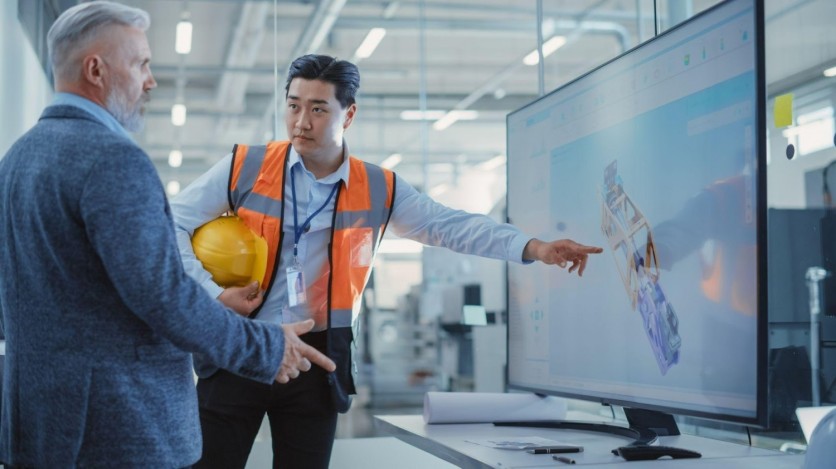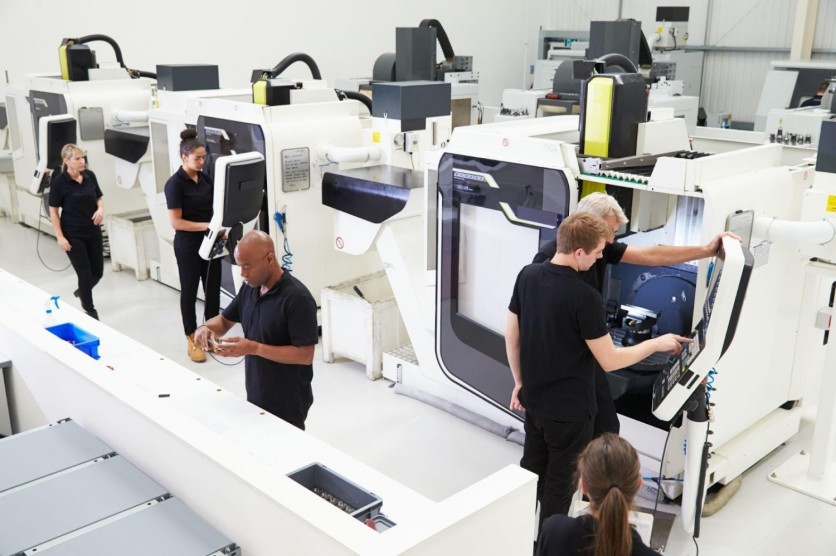
AMFG, established in 2014, has evolved from helping smaller businesses optimize their time and reduce costs to becoming a trusted partner for businesses seeking digital transformation. The company pioneered autonomy for Additive Manufacturing and now empowers global enterprises to achieve unprecedented innovation in both additive and wider manufacturing processes.
With an award-winning MES featuring machine connectivity and cutting-edge software integrations, AMFG streamlines processes across organizations and supply chains, serving clients in over 30 countries, including small machine shops and Fortune 500 giants.
Keyvan Karimi, the founder of AMFG, has an in-depth knowledge of the manufacturing industry as a result of his background in technology management. Combining this knowledge with his fascination for the rapidly-expanding 3D printing industry, he has led the company from strength to strength.
Today, Karimi zooms out on the industry and shares his insights about the future of autonomous processes in manufacturing and the industry as a whole, as AMFG continues to accelerate the adoption of automation and propel the industry into a new era of efficiency and sustainability.
Tell us about your background. What got you interested in manufacturing and 3D printing?
I come from a humble background. My parents - who had immigrated from Iran - highly valued education and enshrined an ethos in me that success is the product of hard work. You either seize the opportunity or let it pass.
From a young age, I looked up to the engineering profession and have always had an obsession with efficiency. After gaining my degree in Industrial Engineering from the South Westphalia University of Applied Sciences, I was already familiar with the manufacturing space, spending the early part of my career working at companies as diverse as Lloyds Bank and Marks & Spencer, primarily in technology management roles.
From there, I started to become excited about the applications of 3D printing, also known as Additive Manufacturing (AM) - so-called because the process "adds" to the material, rather than subtracting from it, as in carving a block of wood or cutting stencils into sheet metal.
The ability to rapidly prototype and the unique material properties of AM-produced parts were signs to me that the technology would be a pivotal one for manufacturing as a whole, and I founded AMFG to bring a comprehensive software solution to this young but as-yet unchoreographed manufacturing method.
At AMFG, we strive for efficiency in every aspect of our work. We scrutinize every operational step and ask ourselves if there's a better way to do things. Operational efficiency is not just a principle we follow - it's ingrained into our DNA.
Give a background of the timeline of 3D printing technology for those of us who aren't familiar.
The history of 3D printing goes back further than people think. The earliest crude additive prototyping machine was working back in the early 80s, with some of the fundamental principles carrying over into today. New techniques were developed into the 90s, but it wasn't until the 2000s that the technology really took off, including the first commercially available printers.
By the early 2010s, "3D printing" was a household name, and the hype train reached its peak in 2014/5, with everybody talking about the technology - meanwhile, floods of investment money poured into the space.
This was the hype that didn't always reflect the fundamentals or the present-day possibilities of the technology, but we're once again seeing fantastic use cases of the technology in commercial markets, and it's this scaling up of the process that I've made it my mission to contribute toward. In some sectors, the advent of additive manufacturing is a game changer.
The technology is now maturing and is increasingly used by even the largest manufacturers, owing to 3D printing's wealth of applications for the space.
So what's the current state of the technology, and what role does AMFG play?
We're seeing significant innovation in 3D printing hardware and materials science, which is driving down the cost and increasing the accessibility of the technology. 3D printing is now being used in wider production setups alongside conventional techniques such as CNC and injection molding.
However, I believe that 3D printing is just another technology that fits into the portfolio of manufacturing businesses. What we identified as a major gap in the market was in the software space - hardware, materials, and resources were disconnected, which we identified as a blocker for 3D printing to materialize in earnest.
This is where AMFG plays a role, with our singular vision to catalyze the industry's takeoff and help businesses scale.
So, fundamentally, we are a software company. We provide MES (Manufacturing Execution System) software, which helps connect all of the disparate parts of the manufacturing process into one streamlined workflow. We are obsessed with transforming the space into a fully autonomous process.
Though our beginnings were humble, and we continue to provide support to a wide customer base of SMB innovators across EMEA and North America in particular, we have grown to be the trusted partner for blue chip companies too - household names like HP, L'Oreal, Ricoh, trust us to streamline their manufacturing processes.
Though we remain the global leader in 3D printing workflow software, we also allow the integration of CNC, injection molding, and sheet metal fabrication into the workflow, meaning AMFG is a one-stop solution for the entire workshop, whether a small two-person operation in the American Midwest or a multinational enterprise.

What direction is the manufacturing industry as a whole heading in? What role does the United States play in this future?
With or without AMFG's intervention, the manufacturing industry is inevitably hurtling toward full automation. Currently, almost all processes and factories require costly human intervention from specialist technicians on-hand to oversee the processes from end to end.
The future, however, is in "lights-out" manufacturing because the process is so entirely automated that the factory can operate with no human intervention whatsoever. We see rapid innovation in the way of self-driving cars, for instance, so it only makes sense that the factories producing such cars should operate in a similarly autonomous manner.
But all of these innovations and changes don't exist only in the manufacturing space in a vacuum. Manufacturing is just one part of a broader societal change, and nowhere can we feel these wheels in motion more than here in the United States.
With each industrial revolution, different forms of industrialization and automation reshape the landscape of work. This next phase is referred to as Industry 4.0, with the previous three epochs being the Industrial, Technological, and Digital Revolutions. Each has changed the landscape of the space in significant and irreversible ways.
First, we have the question of labor. Trends show that there is an aging population among shopfloor technicians and, as such, a skills shortage in the field. This means it's becoming more and more expensive and difficult to train and retain these workers, and businesses looking to improve their bottom line are turning to autonomous processes to solve the issue.
There is understandable pushback on the prospect of replacing blue-collar workers with machines, but this isn't the bad news it sounds like for the American economy. With the Autonomous Revolution comes a great opportunity to re-onshore manufacturing - in other words, thanks to the kinds of solutions AMFG is at the forefront of implementing, we have the ability to bring manufacturing processes back to American shores.
The largest argument for offshoring is the reduction in labor costs across markets in the PRC and other BRIC countries. When this is no longer a competitive factor, manufacturers will inevitably start making decisions to base all operations locally, providing a much-needed boom for American industry.
Aside from the economic advantages, changing political tides suggest that countries like the United States would do best to increase their self-reliance, and the removal of costly and protracted shipping operations means speedier turnaround times, not to mention the environmental savings of having parts produced for the country, in the country.
AMFG's MES today brings benefits that enable businesses to get ahead of this curve, and we already work with numerous proudly "Made in USA" enterprises.
With features such as the Digital Inventory functionality, businesses can eliminate the need for increasingly expensive warehouse floorspace: instead of stacking numerous parts in a factory, gathering dust, the principle of a Digital Warehouse is that these parts are instead stored as digital files on a drive, using smart demand-predicting algorithms and machine learning to optimize for physical space as much as possible and only produce what is needed.
This represents a further time, cost, and space-saving benefit to this exciting new future, and as a company, we are privileged to play such a pivotal role in this development.
How do you see AMFG contributing to the changing manufacturing landscape, given the shift in consumer behavior and industry trends?
It's clear that there are very specific trends emerging in manufacturing, with production set to return in a very different shape from before. As consumer behavior demands ever more individualized products, the manufacturing industry will need to respond with faster lead times and greater variety.
Across industries, from textiles to automotive, the lifecycle of products is getting ever shorter, and so these trends demand a new way of thinking about products and manufacturing.
We can expect to see an intense level of micro-manufacturing activities taking place very close to consumers as production comes back into populated areas in the US. This new model will be highly - or wholly - automated, and it will allow for the production of products that meet our individual needs much faster and in a more sustainable way.
The future will happen with or without AMFG, but we believe that we can play a crucial role in helping to accelerate this transformation. By leveraging cutting-edge manufacturing technologies and innovative software solutions, we can help businesses to streamline their operations and produce products more sustainably and efficiently than ever before.
If we can help to usher in this future sooner, then we will have accomplished our mission.

Connect with Keyvan on LinkedIn.
To learn more about AMFG's award-winning comprehensive MES solution, visit AMFG or schedule a demo.
ⓒ 2025 TECHTIMES.com All rights reserved. Do not reproduce without permission.




